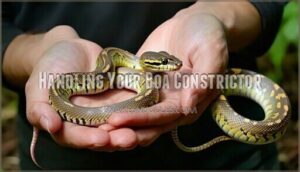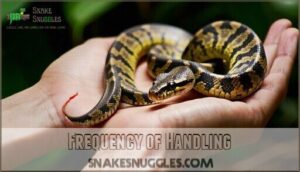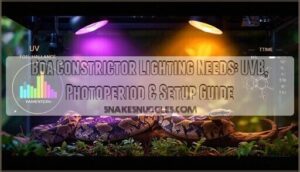This site is supported by our readers. We may earn a commission, at no cost to you, if you purchase through links.

Use a secure tank that’s at least 4 feet long for adults, with a cozy hiding spot and proper heating to maintain temperatures between 75-85°F.
Choose a substrate like aspen bedding or coconut husk to help with humidity, keeping it around 50-70%.
Feed appropriately sized, thawed rodents every 1-2 weeks based on your boa’s age and size.
Handle it calmly and regularly to build trust, but watch for signs of stress, like hissing or excessive movement.
A healthy boa needs consistent care—yours will thrive with proper attention.
Table Of Contents
- Key Takeaways
- How to Care for a Boa Constrictor?
- Boa Constrictor Care Basics
- Setting Up The Boa’s Enclosure
- Handling Your Boa Constrictor
- Establishing a Handling Routine
- Providing Proper Nutrition
- Maintaining Boa Constrictor Health
- Environmental Maintenance
- Shedding and Grooming
- Frequently Asked Questions (FAQs)
- How do you care for a boa constrictor?
- How do you tame a boa constrictor?
- Are boa constrictors healthy?
- Do boa constrictors need a bath?
- Do boa constrictors need water for drinking?
- What are boa constrictors?
- Are boa constrictor easy to care for?
- What do boas need in their tank?
- Do boa constrictors like to be held?
- How often should I hold my boa constrictor?
- Conclusion
Key Takeaways
- Set up a spacious enclosure with proper heating (75-85°F) and humidity (50-70%), along with hiding spots and climbing options.
- Feed your boa appropriately sized frozen-thawed prey every 1-2 weeks based on its size and age.
- Handle your boa calmly and regularly, supporting its body evenly, and avoid handling after feeding or during shedding.
- Monitor your boa’s health by watching for signs of stress or illness, and maintain a clean and hygienic enclosure.
How to Care for a Boa Constrictor?
Caring for a boa constrictor might sound intimidating, but with the right approach, it’s straightforward and rewarding.
With the right setup and care, keeping a boa constrictor is easier than you think—rewarding and fascinating all at once.
Start by setting up a proper boa constrictor enclosure—adults need at least a 75-gallon tank with a basking spot around 90-95°F and a cooler side at 75-80°F.
Maintain humidity levels between 40% and 60%, and add hiding spots to help your snake feel secure.
When it comes to the boa constrictor diet, feed appropriately sized prey every 1-2 weeks, ensuring the meal isn’t larger than the snake’s midsection.
Handle your boa gently, supporting its body evenly, and avoid handling right after feeding. Safe handling also includes using a snake hook to avoid bites and minimize stress.
Boa constrictor care also includes regular health check-ups, monitoring for signs of illness, and keeping its habitat clean. With proper attention to species differences and ethical sourcing, your snake can thrive for its impressive boa lifespan of 20-30 years.
Boa Constrictor Care Basics
Caring for a boa constrictor means meeting its basic needs for space, diet, and handling.
With the right setup and a little effort, you’ll find these snakes are surprisingly manageable and rewarding pets.
Easy to Care For
Boa constrictors are a forgiving species, perfect for beginners exploring snake care.
Their low maintenance needs make them a breeze to manage:
- Simple feeding schedule: Feed every 1–2 weeks, a task even busy owners can handle.
- Beginner-friendly habitat: An adult boa thrives in a 75+ gallon tank with minimal setup.
- Docile temperament: They’re calm and easygoing, requiring minimal handling.
- Straightforward care: Maintain 80–85°F ambient temperature, 90–95°F basking, and use basic substrates like cypress mulch.
These traits make boa constrictor care surprisingly manageable!
Intermediate Care Level
Stepping up from beginner care, boa constrictor care at an intermediate level means focusing on their growing needs.
Keep an eye on diet progression—feeding appropriately sized prey guarantees healthy growth.
An enclosure upgrade is a must as your boa matures; aim for space that matches its length with climbing options for enrichment needs.
Handling frequency should be regular but gentle to build trust, and stay sharp on health monitoring, watching for signs like poor appetite or respiratory issues.
With attention to boa constrictor feeding and handling, you’ll raise a thriving snake.
Setting Up The Boa’s Enclosure
You’ll need to create a spacious, secure enclosure that matches your boa’s size and natural needs.
With the right setup, your snake will stay healthy, comfortable, and safe in its new home.
Tank Requirements
Your boa constrictor setup should mimic its natural environment. Adult boas need an enclosure size of at least 75 gallons, with vivarium types like wood, glass, or plastic working well.
Maintain a temperature gradient: 90-95°F for basking and 75-80°F on the cool side. Keep humidity levels between 40-60%. Add a heat lamp for consistent warmth and provide hiding spots for security.
A well-planned habitat keeps your boa comfortable and thriving. For ideal humidity control, consider using a digital hygrometer.
- Enclosure Size: Minimum 75 gallons
- Temperature Gradient: 90-95°F basking, 75-80°F cool end
- Humidity Levels: 40-60%
Substrate Selection
Choosing the right boa constrictor substrate is key to keeping your snake happy and healthy. Each option has pros and cons, so pick what works for your boa and lifestyle.
Aim for 2-3 inches of depth to retain humidity and cushion your snake. Here’s a quick comparison:
| Substrate | Pros | Cons |
|---|---|---|
| Aspen vs. Cypress | Great for burrowing, natural look | Mold risks if too moist |
| Coir Benefits | Retains moisture, mold-resistant | Dusty when dry |
| Newspaper | Cheap, easy to replace | Lacks aesthetic appeal |
| Bioactive Soil | Natural, supports humidity | Higher maintenance |
Some keepers find success with a DIY substrate mix for their boa constrictors. Clean regularly to prevent impaction risks and maintain boa constrictor humidity.
Handling Your Boa Constrictor
Handling your boa constrictor properly guarantees its safety and helps build trust between you and your pet.
By using slow movements and supporting its body, you’ll make the experience stress-free for both of you.
Handling Tips
When handling your boa constrictor, stay calm and move slowly—think of it as a trust-building exercise.
Use a safe grip and always support their body evenly to avoid stress. Let them explore without forcing interaction.
- Use a snake hook for initial handling or larger boas.
- Read their cues—hissing or striking means they’re uncomfortable.
- Supervise children handling to guarantee safety and proper reptile handling techniques.
To minimize stress, always wash your hands before handling.
Recognizing Signs of Discomfort
When handling your boa, watch for stress signals like hissing sounds, erratic movements, or excessive hiding.
Refusal to feed, scale changes, or unusual tight coiling might point to discomfort or snake health concerns.
Respiratory issues, like wheezing, and other snake diseases, such as scale rot, are common health issues to monitor.
A boa with healthy and smooth skin typically indicates good health.
Recognizing these behaviors early guarantees better snake handling and care.
Always prioritize your boa’s well-being to avoid worsening snake behavior or health problems, ensuring a positive experience with your boa.
Establishing a Handling Routine
Establishing a consistent handling routine helps your boa constrictor feel secure and comfortable around you.
By handling it gently and regularly, you’ll build trust and reduce stress for both you and your snake.
Frequency of Handling
Finding the right balance in boa constrictor handling is key to keeping your snake stress-free and socialized.
Handle your boa 1-2 times a week for 15-20 minutes, ensuring it’s outside sensitive periods like shedding or post-feeding.
Pay attention to snake behavior and temperament—watch for signs of discomfort like hissing or sudden movements.
Regular handling builds confidence but avoid overdoing it.
A calm, gentle approach fosters trust while reducing handling stress.
Remember, every boa’s unique, so adjust based on their personality and size.
Building Trust With Your Boa
To build trust with your boa constrictor, focus on consistent interaction and gentle handling.
Use scent familiarization by letting your boa recognize your presence before handling.
Practice gradual introduction to new surroundings, boosting its confidence.
Pay attention to snake behavior and temperament, recognizing cues like relaxed movements.
Incorporate positive reinforcement—no treats needed, just calm, steady handling—to create a bond over time.
Providing Proper Nutrition
Feeding your boa constrictor the right diet is key to keeping it healthy and thriving.
You’ll need to provide appropriately sized prey on a consistent schedule to match its growth and energy needs.
Feeding Schedule
A solid feeding schedule keeps your boa healthy and thriving.
Younger snakes need meals more often, about once a week, while adults are fine with feeding every two weeks.
Always match the prey size to your boa’s widest midsection to avoid regurgitation risks.
Stick to frozen-thawed prey like mice or rats for a safe, balanced snake diet.
- Juvenile schedule: Weekly meals for steady growth.
- Adult schedule: Every 10–14 days to prevent obesity.
- Feeding frequency: Adjust based on activity and appetite.
Consistency is key for happy, well-fed boas!
Meal Size and Frequency
When planning your boa constrictor feeding, focus on prey size—it should match the snake’s thickest midsection.
For juveniles, offer meals every 7–10 days, while adult feeding should occur every 2–3 weeks.
Stick to thawed, frozen prey like mice or rats to avoid injury risks from live snake food.
Overfeeding can lead to obesity risks, organ stress, and shorter lifespans, so adjust portions based on body condition.
A proper snake diet keeps your boa healthy and guarantees long-term success with your feeding schedule.
Maintaining Boa Constrictor Health
Keeping your boa constrictor healthy means staying alert to changes in behavior or appearance and scheduling regular vet check-ups.
Watch for common issues like respiratory infections or shedding problems, and address them promptly to guarantee your snake thrives, which is crucial for maintaining its overall health and ensuring it thrives.
Regular Health Check-ups
Regular veterinarian visits are a smart move to keep your boa healthy and thriving. Schedule an annual veterinary check to assess their overall condition, check for pests, and perform preventative care like fecal exams.
Spotting illness indicators early can save you headaches—and your snake’s life.
Here’s how to stay on top of reptile health:
- Track behavior and habits: Keep a journal of shedding cycles, feeding patterns, and activity levels. Changes might signal health issues.
- Learn illness indicators: Look for signs like lethargy, cloudy eyes, or breathing issues.
- Quarantine new snakes: Always isolate new additions to prevent spreading infections.
A little effort upfront guarantees your boa slithers happily for years!
Common Health Issues
Common boa constrictor diseases can sneak up quickly, so it’s important to stay vigilant.
Watch for respiratory infections (wheezing or bubbling), mouth rot (caused by poor hygiene), or scale rot (often linked to humidity issues).
Other problems like mite infestations, weight loss, or regurgitation causes should never be ignored.
Quick action is your snake’s best defense.
| Condition | Symptoms | Causes |
|---|---|---|
| Respiratory Infections | Wheezing, bubbling | Low tank temperature |
| Mouth Rot | Swollen mouth, lethargy | Poor enclosure hygiene |
| Scale Rot | Discolored scales | Incorrect humidity levels |
| Mite Infestations | Irritated skin, itching | Dirty tank environment |
| Regurgitation Causes | Vomiting prey | Overfeeding, stress |
Environmental Maintenance
Keeping your boa’s environment clean and well-maintained is essential for its health and comfort.
Regularly monitor the enclosure’s temperature, humidity, and cleanliness to verify everything stays within safe and ideal ranges.
Tank Cleaning
Keeping your snake enclosure clean is vital for your boa’s health.
Spot-clean daily to handle waste removal and replace soiled snake substrate.
Every 4–6 weeks, perform a deep clean: remove your boa, the water bowl, and decor.
Use reptile-safe disinfectants for all surfaces, ensuring substrate replacement and proper reassembly afterward.
Selecting the right snake bedding material is essential for hygiene.
A consistent cleaning schedule prevents harmful bacteria and keeps odors away.
Your boa will thank you with fewer grumpy moods!
Humidity and Temperature Control
After cleaning your boa’s tank, focus on maintaining proper humidity and temperature. Stable conditions mimic their natural habitat and keep them healthy.
Follow these steps:
- Humidity levels: Keep between 55%-75% using a hygrometer; provide a water bowl for soaking.
- Temperature gradient: Maintain 75-85°F, with basking spots at 95°F.
- Monitoring equipment: Use thermostats and sensors for precise temperature maintenance. Consider using a reliable boa hygrometer for accurate readings.
- Seasonal adjustments: Slightly lower nighttime temperatures during cooler months.
Your boa will appreciate the comfortable setup!
Shedding and Grooming
Shedding is a natural part of your boa constrictor’s growth, and it’s your job to make the process as smooth as possible.
By maintaining proper humidity and checking for stuck skin, you’ll keep your snake comfortable and healthy, which is crucial for its overall well-being, particularly during growth.
Shedding Process
Shedding is a natural part of your boa constrictor’s growth. Watch for signs shedding is near, like dull skin and cloudy eyes.
Dull skin and cloudy eyes? Your boa’s shedding spa day is near—boost humidity and watch the magic happen!
Boost humidity to 70%—it’s key for snake care. If retained shed occurs, gently aid shedding with damp towels or moss.
Proper humidity prevents dysecdysis, ensuring smooth sheds. Think of it as your snake’s spa day!
Grooming Practices for Boas
Healthy scale health starts with good hydration methods.
Boost enclosure humidity to 70% during shedding and watch for stuck eye caps or skin. Offer a shallow soak or mist daily to prevent shedding problems.
Keep substrate clean to avoid snake mites. Regular enclosure sanitation promotes comfort, while proper humidity helps your boa shed smoothly—happy snake, happy owner!
Always approach your boa calmly, as sudden movements trigger strikes, to ensure a safe and enjoyable experience with your boa.
Frequently Asked Questions (FAQs)
How do you care for a boa constrictor?
Caring for a boa constrictor means providing a secure, spacious enclosure, humidity around 70%, fresh water, and feeding properly sized prey every 1-3 weeks.
Handle gently, avoid stress, and monitor health regularly.
How do you tame a boa constrictor?
Tame your boa constrictor by handling it regularly with calm, steady movements.
Support its body fully, avoid sudden motions, and give it time to trust you.
Patience and consistency work wonders—don’t rush the process!
Are boa constrictors healthy?
Robust, resilient, and relatively low-maintenance, boa constrictors typically stay healthy with proper care.
Keep their enclosure clean, feed them appropriately, and monitor for signs of illness.
Regular vet check-ups help guarantee your boa’s long-term well-being, with proper care being essential to their health.
Do boa constrictors need a bath?
Boa constrictors don’t need baths unless they’re shedding poorly or covered in dirt.
Instead, maintain high enclosure humidity and provide fresh water.
Occasionally, a damp towel works wonders for stubborn shed—no spa day required!
Do boa constrictors need water for drinking?
Yes, they absolutely do!
Keep fresh, clean water in their enclosure at all times.
Hydration’s essential, plus they might soak occasionally during shedding.
Use a sturdy, tip-proof bowl to avoid spills, as hydration is crucial.
What are boa constrictors?
They’re large, non-venomous snakes that constrict prey to survive.
Often reaching 6-10 feet, they’re generally docile, but require proper care.
These fascinating reptiles thrive in warm environments with specific enclosures, regular feeding, and attentive handling.
Are boa constrictor easy to care for?
They’re fairly easy to care for if you’re prepared.
You’ll need a spacious enclosure, controlled humidity, and regular feedings.
They’re low-maintenance but require commitment—like owning a calm, scaly roommate with strict temperature preferences, which can be considered a commitment.
What do boas need in their tank?
Picture a cozy jungle—boas need a spacious tank with secure lids, dry hiding spots, sturdy branches for climbing, and proper substrate like aspen shavings.
Keep temps warm, humidity high, and water fresh.
Do boa constrictors like to be held?
Boa constrictors don’t “like” being held, but they tolerate it if handled gently and regularly.
Move slowly, support their body fully, and avoid handling after meals.
They’re solitary creatures, so don’t overdo it.
How often should I hold my boa constrictor?
Try holding your boa 1-3 times a week for short sessions.
This helps it stay calm and accustomed to handling.
Don’t overdo it, though—snakes enjoy their alone time, just like some introverted friends!
Conclusion
It’s ironic how a creature known for squeezing is so easy to care for with the right setup.
Mastering how to care for a boa constrictor means creating a safe enclosure, maintaining proper humidity and temperature, feeding correctly, and handling with patience.
Keep an eye on its health and stress cues, and you’ll have a thriving, fascinating pet.
With consistency and attention, you’ll build trust, and your boa will feel like part of the family—minus the hugs!
- https://www.reptilecentre.com/pages/info-boa-care-sheet
- https://www.thebiodude.com/blogs/snake-caresheets/boa-constrictor-care-guide-and-bioactive-terrarium-maintenance
- https://reptifiles.com/boa-constrictor-care
- https://odorpatrol.tumblr.com/boaconstrictorhusbandry
- https://reptilesmagazine.com/colombian-boa-constrictor-care-sheet
















